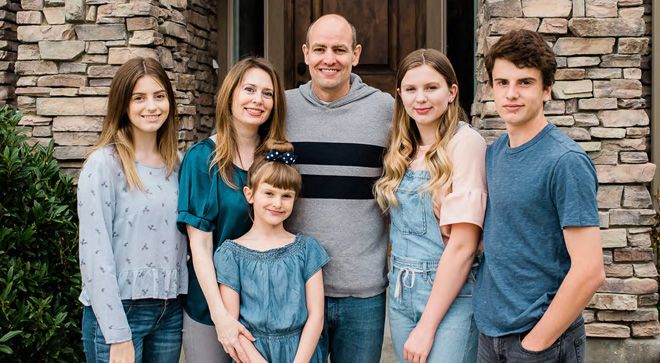Publication
Article
CURE
Keeping Their Options Open: Head and Neck Cancer Treatment Evolves
Author(s):
Patients with head and neck cancer may soon have more effective, less toxic choices as immunotherapy moves into first-line treatment and novel targeted drugs are explored.
When Jason Campbell, D.D.S., started having neck pain in July 2017, he suspected it was the consequence of spending hours each week hunched over the mouths of patients in his dental practice. But six months later, during a marathon training run, Campbell, 45, experienced double vision, nausea and head pain and rushed to the hospital. MRI results revealed a golf ball-size tumor near his brainstem, and his doctors suspected that the growth was chordoma, a rare type of cancer in the cells at the base of the skull.
A biopsy revealed a different source: Campbell’s cancer had originated in the squamous cells near the upper part of his throat and then spread to the base of the skull. For his diagnosis of stage 4 nasopharyngeal head and neck cancer, Campbell received chemotherapy with docetaxel and 5-fluorouracil (5-FU) for one week, followed by radiation treatment combined with the platinum-based chemotherapy cisplatin for two months.
“It was the hardest thing I’ve ever done physically,” says Campbell, of Orem, Utah. Eating was painful and he lost 50 pounds, but Campbell was determined to avoid using a feeding tube. He performed physical therapy five times a day to maintain his ability to swallow. By November, there was no evidence of cancer on scans, and Campbell celebrated with his wife and five children.

Jason Campbell, fourth from left, has received support from his family during treatment for head and neck cancer. Family members are, from left: MARLEY (17), his wife MOLLY, AUDREY (8), RACHEL (13), CALEB (15). Not shown is MORGAN (22).
Six months later, a routine scan showed that the cancer had spread to his lungs. Doctors gave Campbell six months to live.
Campbell prayed for guidance and started searching for clinical trials. A friend suggested that he seek out Ezra Cohen, M.D., a specialist in head and neck cancer at the University of California, San Diego (UC San Diego). Cohen, associate director of translational science at Moores Cancer Center there, was just starting a clinical trial that included a combination of one immunotherapy — Bavencio (avelumab) — and two targeted therapies, Erbitux (cetuximab) and Ibrance (palbociclib). Each drug would target the cancer cells, either by directly inhibiting growth or by preventing cancer growth via the immune system.
Campbell was the first patient to start the trial. He began in June 2018 with more than 35 lung tumors that were doubling in size every two months. After eight months of weekly infusions, just eight small tumors remained — and the side effects of treatment were minimal.
“I feel very lucky to be the first person in the world to receive this treatment, and other than a little fatigue the first few days after my infusions, I feel good,” Campbell says.
This ability to help patients like Campbell represents a dramatic shift in head and neck cancer treatment, according to Cohen. “This is probably the most active period of drug development in head and neck cancer — possibly ever,” he says.
Although surgery, radiation and chemotherapy are at the heart of standard care for this disease, Erbitux started to generate excitement when it was approved for head and neck cancer in 2006. The drug interferes with the activity of a protein called epidermal growth factor receptor (EGFR), which drives some head and neck cancers. However, results were not impressive. “The response rate was less than 10 percent, and the duration of response was in months,”
Cohen says.
The latest Food and Drug Administration approvals related to the disease came in 2016: the immunotherapies Keytruda (pembrolizumab) and Opdivo (nivolumab), which target the PD-1 receptor protein on the surface of immune cells. By targeting this protein, these drugs can prevent cancer cells from hiding from the immune system and enable T cells to attack the cancer. “Now, we are seeing patients who can have a durable response for years, and we had not seen that before,” Cohen says.
EFFECTS OF THE HPV EPIDEMIC
Head and neck cancer accounts for about 4 percent of all cancers in the United States and is more common in men. Although the greatest risk factors historically involve use of tobacco and alcohol, this form of cancer is increasingly linked to HPV, which 80 percent of sexually active people contract at some point. Researchers predict that by 2030, half of all head and neck cancers will be attributed to this virus, but oncologists are already seeing that percentage. “About half of my patients with head and neck cancer have HPV-related disease,” says Robert Ferris, M.D., Ph.D., director of University of Pittsburgh Medical Center’s Hillman Cancer Center.
The good news is that people with the HPV-derived type usually have a better prognosis than other patients with head and neck cancer, even though all get the same kinds of treatments. This may be because the virus produces a good target for the immune system and most HPV-associated head and neck cancers express PD-L1, making them more sensitive to immunotherapy, Cohen says.
HPV-related tumors usually reside in the oropharynx, the part of the throat at the back of the mouth behind the oral cavity, and the cancer often starts in the tonsils. Patients may notice symptoms such as a lump in the neck or throat, swallowing problems, bleeding or a persistent earache.
Non-HPV-related head and neck cancers are often found at the front of the mouth or down in the neck, where the larynx and vocal cords are located. Symptoms include trouble breathing or speaking, pain when swallowing, persistent pain in the neck or throat or a change in voice.
Two-thirds of head and neck cancers are diagnosed in advanced, but rarely metastatic, stages, Cohen says.
Treatment depends on the stage and location of the cancer, and physicians weigh the potential benefits of surgery, radiation and chemotherapy. “With early-stage disease, we use as few modalities as possible, because each treatment causes side effects,” Ferris says. “In the later stages, we tend to intensify treatments by combining radiation with chemotherapy and sometimes using immunotherapy.”
Standard treatments can produce a number of side effects, some long-lasting or permanent. Surgically removing parts of the head or neck can result in trouble speaking, eating or swallowing, as well as disfigurement; choosing doctors who are experts in this kind of surgery helps minimize these effects. Radiation can cause mouth and gum sores and difficulty swallowing, and chemotherapy such as cisplatin can cause vomiting, fatigue and hair loss.
When Erbitux was approved in combination with radiation, the drug was considered a less-toxic alternative to cisplatin. However, the recent results of a clinical trial in patients with HPV-positive oropharyngeal cancer showed better survival rates with cisplatin plus radiation — and the overall toxicity was similar between the two combinations.
“There is a lot of active research looking at alternatives to cisplatin, because the combination of this drug plus radiation is some of the hardest cancer treatment we put patients through in the outpatient setting, in terms of acute toxicity and long-term side effects,” says Rom Leidner, M.D., medical co-director of the head and neck cancer program at Earle A. Chiles Research Institute in Portland, Oregon. “But for now, cisplatin plus radiation has been proven to have superior survival outcomes.”
The longer-term side effects of cisplatin plus radiation, Cohen notes, can include difficulty speaking and/or swallowing, tightness and/or pain in the neck, dry mouth and dental decay.
THE BENEFITS OF IMMUNOTHERAPY
Until Keytruda and Opdivo were approved for recurrent or metastatic head and neck cancer, patients with advanced disease had few options after receiving the standard Erbitux plus 5-FU and either cisplatin or carboplatin. Now, studies are showing that these immunotherapies may also have benefits as treatments for newly diagnosed disease.
In one study, Barbara Burtness, M.D., compared patients who received Keytruda alone with those who received Erbitux and a platinum-based chemotherapy (cisplatin or carboplatin) plus 5-FU. A third group received Keytruda with a platinum agent and 5-FU. Her team also tested the level of PD-L1 expression in tumor cells. In patients with high levels of PD-L1 expression, Keytruda lengthened survival by 4.2 months compared with patients who received Erbitux plus chemotherapy. The results also showed that Keytruda plus chemotherapy helped patients regardless of whether their tumors expressed PD-L1.
“The implication is that patients who have PD-L1-expressing cancers should receive Keytruda as a first-line treatment instead of two chemotherapy drugs plus cetuximab,” says Burtness, co-director of the developmental therapeutics research program and team leader of disease-aligned research for head and neck cancer at Yale Cancer Center. “But we do not have all the information yet. We need to find out who should get Keytruda alone versus Keytruda with chemotherapy.”
Burtness is now investigating whether Keytruda could help patients who do not have a complete response to chemotherapy and radiation and are left with the option of surgeries that could affect the tongue or voice box.

JOSEPH FRANCHI discovered his cancer had spread to his brain after he lost the ability to juggle five objects.
Joseph Franchi says he believes that trying immunotherapy earlier might have helped him avoid serious side effects from treatment. Franchi, of Westport, Connecticut, thought he had strep throat in 2012, but even after a round of antibiotics, he felt scratchiness for months. His physician later discovered a tumor wrapped around Franchi’s right tonsil, and biopsy results revealed squamous cell carcinoma. By far the most common type of head and neck cancer, it begins in the cells that line the moist areas inside the head and neck. After a combination of surgery and radiation treatment, the cancer was in remission for three years.
Then, in 2015, it returned in his lungs and pericardium, the membrane surrounding his heart. Franchi was referred to Burtness, who recommended a combination of chemotherapy and Erbitux.
“I had a reaction to the carboplatin during the chemotherapy infusion and my palms became extremely itchy, and it felt like bees were stinging the bottoms of my feet,” says Franchi, 52, who until recently worked at a financial software company. He stopped taking the drug, but then his lungs developed inflammation as a result of the second chemotherapy, paclitaxel. He stopped the chemotherapy drugs and continued taking Erbitux.
The cancer was in remission for more than six months, but then a change caught his attention. An experienced juggler, Franchi suddenly lost his ability to juggle five objects simultaneously. He returned to the doctor and discovered that cancer had spread to his brain, which prompted Burtness to suggest that he start taking Keytruda in early 2017.
“The scans are now showing no new growth of the cancer,” Franchi says. “Although I feel tired, overall I feel pretty good.”
EXPLORING NEW TREATMENTS
Even though Keytruda is helping patients like Franchi, researchers are studying how to raise response rates to these drugs. Currently, about 15 percent of eligible patients with head and neck cancer respond to the approved immunotherapies, but a strategy that Cohen used has doubled this number by combining the PD-1 inhibitors with a drug that targets STAT3, a protein in the body that transmits signals to trigger the maturation of immune cells. In studies in mice and cell lines, he has also experimented with combining a PD-1 inhibitor with molecules that turn on “toll-like receptors” involved in the first step of an immune response.
Cohen is also working with Kathryn Gold, M.D., an associate professor at UC San Diego Health, to investigate the benefit of combining two targeted therapies — one that blocks EGFR to prevent cancer cell growth and one that inhibits the proteins CDK 4 and 6 — with a PD-1-inhibiting immunotherapy. Campbell is a patient in this trial, and Cohen hopes to understand why he’s benefiting from the combination. “We are discovering that these drugs may complement one another,” Cohen says. “Disrupting the EGFR signaling can make the PD-1 antibodies work better, so the combination helps both drugs work better.”
Researchers are also exploring whether HPV vaccines could boost immune responses in patients with HPV-related head and neck cancer. “The virus is still expressed in the cancer, and a vaccine may also complement existing therapies,” Cohen says.
Compared with chemotherapy, immunotherapies tend to have fewer and different side effects — rash, diarrhea, low thyroid hormone, fatigue — and researchers are exploring whether using less radiation could further reduce unwanted effects. In one recent study, investigators decreased the dose given to patients with low-risk HPV-positive cancers. They also tried administering chemotherapy plus a reduced amount of radiation in patients with more aggressive HPV-positive cancers. “The survival outcomes were excellent, and people recovered significantly faster (and) had less pain, and the functional outcomes were better,” says Tanguy Seiwert, M.D., director of the head and neck cancer program at the University of Chicago and first author of the study.
Patients like David Simmons, a pastor in Greenville, South Carolina, can attest to the benefits of less radiation. Simmons was 54 when doctors discovered a malignant squamous cell carcinoma the size of an orange in his neck. He had been experiencing ear pain and passed out as a result of pressure from the tumor on his vagus nerve. In 2013, Simmons started receiving a combination of chemotherapy and radiation, but the treatment shrank his vocal cords and permanently constricted his throat. Simmons now uses a feeding tube to eat and has difficulty speaking.

DAVID SIMMONS is doing well on immunotherapy for recurrent head and neck cancer.
“The treatment was successful at the time, but I paid the price in other ways,” says Simmons, who lost 85 pounds during the treatment and struggled with comprehension while reading for months afterward. “I lost my voice for four weeks, and people still have trouble understanding me.”
Simmons remained cancer-free for more than two years, but the disease returned in his right knee, prompting his oncologist to recommend a regimen of cisplatin and 5-FU. The 5-FU caused neutropenia and a blood count problem that put him at high risk of infections, and later he had an anaphylactic reaction to cisplatin. In January 2018, the oncologist suggested a new approach: infusions of Keytruda once every three weeks. His response far exceeded his physician’s expectations. After three months, the tumors were shrinking in his leg; six months later, the cancer was almost gone.
Now that he’s no longer as vulnerable to infections, Simmons is enjoying the freedom to visit hospitalized members of his congregation. He also felt strong enough for summertime travel to Yellowstone National Park and the Grand Canyon.
“Earlier during treatment, I felt like I was going to die several times, and I spent many days in the hospital,” Simmons says. “Since I started immunotherapy, I feel like I have a new lease on life, and I’m grateful for the extra time with my wife and grandchildren.”






